Flood Control and Aquifer Recharge Effects of Sponge City: A Case Study in North China
Abstract
:1. Introduction
2. Materials and Methods
2.1. Study Area
2.2. Methods
2.2.1. SWMM
2.2.2. MODFlow
3. Results
3.1. Sponge City Design Scheme
3.1.1. Natural Hydrographic Network Design
- River
- Lake and water corridor
3.1.2. LID Facility Design
3.1.3. Drainage System Design
3.1.4. Sponge City Scheme
3.2. Stormwater Control Effect
3.3. Groundwater-Recharge Effect
4. Conclusions
Author Contributions
Funding
Data Availability Statement
Conflicts of Interest
References
- Research Group of Control and Countermeasure of Flood. Control and countermeasure of flood in China. China Flood Drought 2014, 3, 46–48. [Google Scholar]
- Chan, F.K.S.; Griffiths, J.; Higgitt, D.; Xu, S.Y.; Zhu, F.F.; Tang, Y.T.; Xu, Y.Y.; Thorne, C. “Sponge City” in China—A breakthrough of planning and flood risk management in the urban contex. Land Use Policy 2018, 76, 772–778. [Google Scholar] [CrossRef]
- Lyu, H.M.; Sun, W.J.; Shen, S.L.; Arulrajah, A. Flood risk assessment in metro systems of mega-cities using a GIS-based modeling approach. Sci. Total Environ. 2018, 626, 1012–1015. [Google Scholar] [CrossRef]
- Zhang, S.Y.; Zevenbergen, C.; Rabe, P.; Jiang, Y. Influences of Sponge City on Property Values in Wuhan, China. Water 2018, 10, 766. [Google Scholar] [CrossRef] [Green Version]
- Lancia, M.; Zheng, C.; He, X.; Lerner, D.N.; Tian, Y. Hydrogeological constraints and opportunities for “Sponge City” development: Shenzhen, southern China. J. Hydrol. Reg. Stud. 2020, 28, 772–778. [Google Scholar] [CrossRef]
- Geiger, W.F. Sponge city and LID technology vision and tradition. Landsc. Archit. Front. 2015, 3, 10–20. [Google Scholar]
- Tazioutzios, C.; Kastridis, A. Multi-Criteria Evaluation (MCE) method for the management of woodland plantations in floodplain areas. Int. J. Geo-Inf. 2020, 9, 725. [Google Scholar] [CrossRef]
- Bertrand-Krajewski, J.L. Intergrated urban stormwater management: Evolution and multidisciplinary perspective. J. Hydro-Environ. Res. 2021, 38, 72–83. [Google Scholar] [CrossRef]
- Zhu, Y.F.; Xu, C.Q.; Yin, D.K.; Xu, J.X.; Wu, Y.Q.; Jia, H.F. Environmental and economic cost-benefit comparison of Sponge City construction in different urban functional regions. J. Environ. Manag. 2022, 304, 114230. [Google Scholar] [CrossRef]
- Tu, X.M.; Tian, T.N. Questions towards a sponge city report on power of public policy: Sponge city and the trend of landscape architecture. Landsc. Archit. Front. 2015, 3, 22–30. [Google Scholar]
- Yin, D.K.; Chen, Y.; Jia, H.F.; Wang, Q.; Chen, Z.X.; Xu, C.X.; Li, Q.; Wang, W.L.; Yang, Y.; Fu, G.T.; et al. Sponge City Practice in China: A Review of Construction, Assessment, Operational and Maintenance. J. Clean. Prod. 2021, 280, 124963. [Google Scholar] [CrossRef]
- Xu, Y.S.; Shen, S.L.; Lai, Y.; Zhou, A.N. Design of sponge city: Lessons learnt from an ancient drainage system in Ganzhou, China. J. Hydrol. 2018, 563, 900–908. [Google Scholar] [CrossRef]
- Chen, S.Y.; Van de Ven, F.H.M.; Zevenbergen, C.; Verbeeck, S.; Ye, Q.H.; Zhang, W.J.; Wei, L. Revisiting China’s Sponge City planning approach: Lessons from a case study on Qinhuai District, Nanjing. Front. Environ. Sci. 2021, 9, 748231. [Google Scholar] [CrossRef]
- Wang, Y.T.; Sun, M.X.; Song, B.M. Public perceptions of and willingness to pay for sponge city initiatives in China. Resour. Conserv. Recycl. 2017, 122, 11–20. [Google Scholar] [CrossRef]
- Xie, X.H.; Qin, S.Y.; Gou, Z.H.; Yi, M. Engaging professionals in urban stormwater management: The case of China’s Sponge City. Build. Res. Inf. 2020, 48, 719–730. [Google Scholar] [CrossRef]
- Zhang, C.H.; He, M.Y.; Zhang, Y.S. Urban sustainable development based on the framework of sponge city: 71 case study in China. Sustainability 2019, 11, 1544. [Google Scholar] [CrossRef] [Green Version]
- Yang, M.; Sang, Y.F.; Sivakumar, B.; Chan, F.K.S.; Pan, X. Challenges in urban stormwater management in Chinese cities: A hydrologic perspective. J. Hydrol. 2020, 591, 125314. [Google Scholar] [CrossRef]
- Mooers, E.W.; Jamieson, R.C.; Hayward, J.L.; Drage, J.; Lake, C.B. Low-impact development effects on aquifer recharge using coupled surface and groundwater models. J. Hydrol. Eng. 2018, 23, 04018040. [Google Scholar] [CrossRef]
- Newcomer, M.E.; Gurdak, J.J.; Sklar, L.S. Urban recharge beneath low impact development and effects of climate varibility and change. Water Resour. Res. 2014, 50, 1716–1734. [Google Scholar] [CrossRef]
- Jin, M.X.; Lancia, M.; Tian, Y.; Viaroli, S.; Andrews, C.; Liu, J.; Zheng, C. Hydrogeological criteria to improve the sponge city strategy of China. Front. Environ. Sci. 2021, 9, 700463. [Google Scholar] [CrossRef]
- Lancia, M.; Zheng, C.M.; Yi, S.P.; Lerner, D.N.; Andrews, C. Analysis of groundwater resources in densely populated urban watersheds with a complex tectonic setting: Shenzhen, southern China. Hydrogeol. J. 2019, 27, 183–194. [Google Scholar] [CrossRef] [Green Version]
- Lancia, M.; Su, H.; Tian, Y.; Xu, J.T.; Andrews, C.; Lerner, D.N.; Zheng, C.M. Hydrogeology of the Pearl River Delta, southern China. J. Maps 2020, 16, 388–395. [Google Scholar] [CrossRef]
- Su, Y.; Li, T.X.; Cheng, S.K.; Wang, X. Spatial distribution exploration and driving factor identification for soil salinisation based on geodetector models in coastal area. Ecol. Eng. 2020, 156, 105961. [Google Scholar] [CrossRef]
- Kang, H.Z.; Chen, L.; Guo, Q.Z.; Lian, J.J.; Hou, J. An overview of quantification of groundwater recharge in sponge city construction. Earth Sci. Front. 2019, 26, 58–65. [Google Scholar]
- Sun, K.N.; Hu, L.T.; Liu, X.M. The influences of sponge city construction on spring discharge in Jinan city of China. Hydrol. Res. 2020, 51, 959–975. [Google Scholar] [CrossRef]
- Ji, M.C.; Bai, X. Construction of the sponge city regulatory detailed planning index system based on the SWMM model. Environ. Technol. Innov. 2021, 23, 101645. [Google Scholar] [CrossRef]
- Zhou, J.J.; Liu, J.H.; Shao, W.W.; Yu, Y.D.; Zhang, K.; Wang, Y.; Mei, C. Effective evaluation of infiltration and storage measures in sponge city construction: A case study of Fenghuang City. Water 2018, 10, 937. [Google Scholar] [CrossRef] [Green Version]
- Zhou, Y.X.; Sharma, A.; Masud, M.; Gaba, G.S.; Dhiman, G.; Ghafoor, K.Z.; AIZain, M.A. Urban rain flood ecosystem design planning and feasibility study for the enrichment of smart cities. Sustainability 2021, 13, 5205. [Google Scholar] [CrossRef]
- Yang, Y.Y.; Li, J.; Huang, Q.; Xia, J.; Li, J.K.; Liu, D.F. Performance assessment of sponge city infrastructure on stormwater outflows using isochrone and SWMM models. J. Hydrol. 2021, 597, 126151. [Google Scholar] [CrossRef]
- Yin, D.K.; Evans, B.; Wang, Q.; Chen, Z.X.; Jia, H.F.; Chen, A.S.; Fu, G.T.; Ahmad, S.; Leng, L.Y. Integrated 1D and 2D model for better assessing runoff quantity control of low impact development facilities on community scale. Sci. Total Environ. 2020, 720, 137630. [Google Scholar] [CrossRef]
- Zhengzhou Urban and Rural Planning Bureau. Technical Provisions on Urban Management of Zhengzhou City (2018 Revised Version); Office of Zhengzhou Urban and Rural Planning Bureau: Zhengzhou, China, 2018. (In Chinese) [Google Scholar]
- Wang, Y.T.; Sun, M.X.; Song, B.M. A framework to support decision making in the selection of sustainable drainage system design alternatives. J. Environ. Manag. 2017, 201, 145–152. [Google Scholar] [CrossRef]
- Tang, S.J.; Jiang, J.; Zheng, Y.; Hong, Y.; Chung, E.S.; Shamseldin, A.Y.; Wei, Y.; Wang, X.H. Robustness analysis of storm water quality modeling with LID infrastructures from natural event-based field monitoring. Sci. Total Environ. 2020, 753, 142007. [Google Scholar] [CrossRef] [PubMed]
- Luan, Q.H.; Fu, X.R.; Song, C.P.; Wang, H.C.; Liu, J.H.; Wang, Y. Runoff Effect Evaluation of LID through SWMM in Typical Mountainous, Low-Lying Urban Areas: A Case Study in China. Water 2017, 9, 439. [Google Scholar] [CrossRef] [Green Version]
- Rossman, L.A. Storm Water Management Model User’s Manual Version 5.1; United States Environmental Protection Agency: Cincinnati, OH, USA, 2015. [Google Scholar]
- Liu, X.P. Parameter calibration method for urban rainfall-runoff model based on runoff coefficient. Water Wastewater Eng. 2009, 35, 213–217. (In Chinese) [Google Scholar]
- Beijing Municipal Design and Research Institute. Concise Drainage Design Manual; China Construction Industry Press: Beijing, China, 1990; p. 241. [Google Scholar]
- Ashraf, M.; Kahlown, M.A.; Ashfaq, A. Impact of small dams on agriculture and groundwater development: A case study from Pakistan. Agric. Water Manag. 2007, 92, 90–98. [Google Scholar] [CrossRef]
- Kastridis, A.; Stathis, D. The effect of small earth dams and reservoirs on water management in North Greece (Kerkini municipality). Silva Balc. 2015, 16, 71–84. [Google Scholar]
- Zhu, Q.; Yu, K.J.; Li, D.H. The width of ecological corridor in landscape planning. ACTA Ecol. Sin. 2005, 25, 2406–2412. (In Chinese) [Google Scholar]
- Hou, F. Research on the Urban Ecological Corridor Planning Based on Sponge City—Green Corridor of Fengxi New City as a case study. Master’s Thesis, Chang’an University, Xi’an, China, June 2017. (In Chinese). [Google Scholar]
- Xu, C.Q.; Shi, X.M.; Jia, M.Y.; Han, Y.; Zhang, R.R.; Ahmad, S.; Jia, H.F. China Sponge City database development and urban runoff source control facility configuration comparison between China and the US. J. Environ. Manag. 2022, 304, 114241. [Google Scholar] [CrossRef] [PubMed]

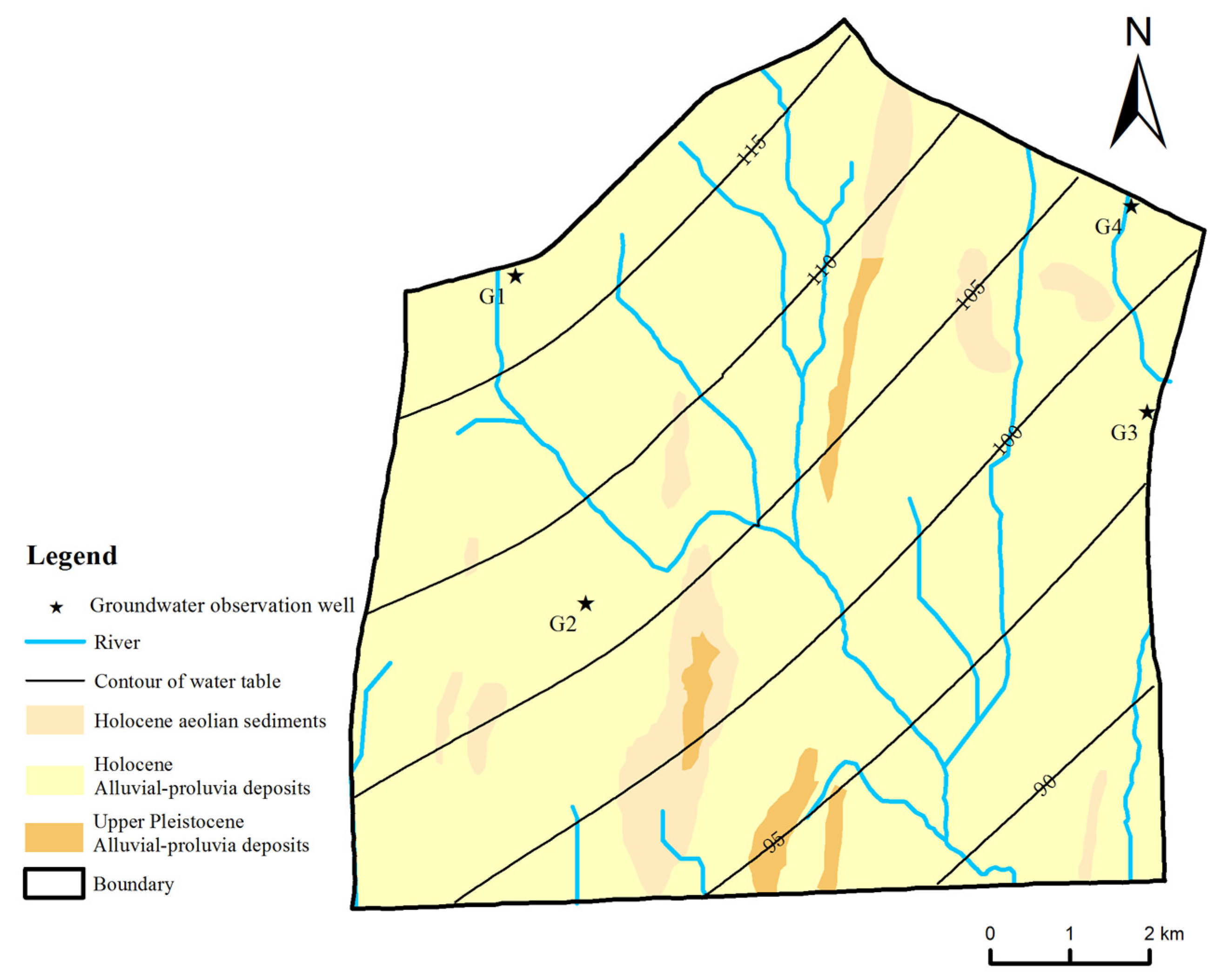
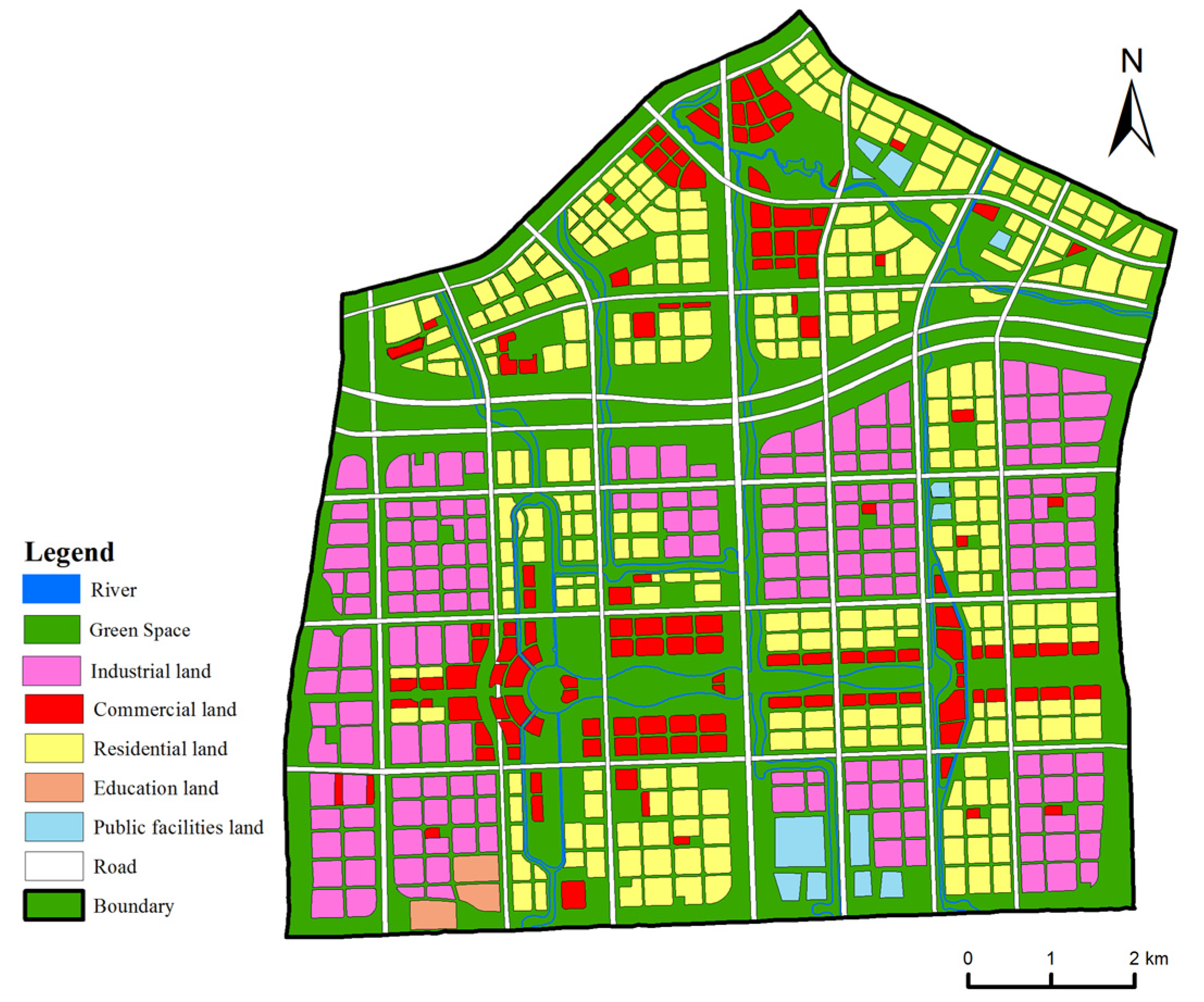
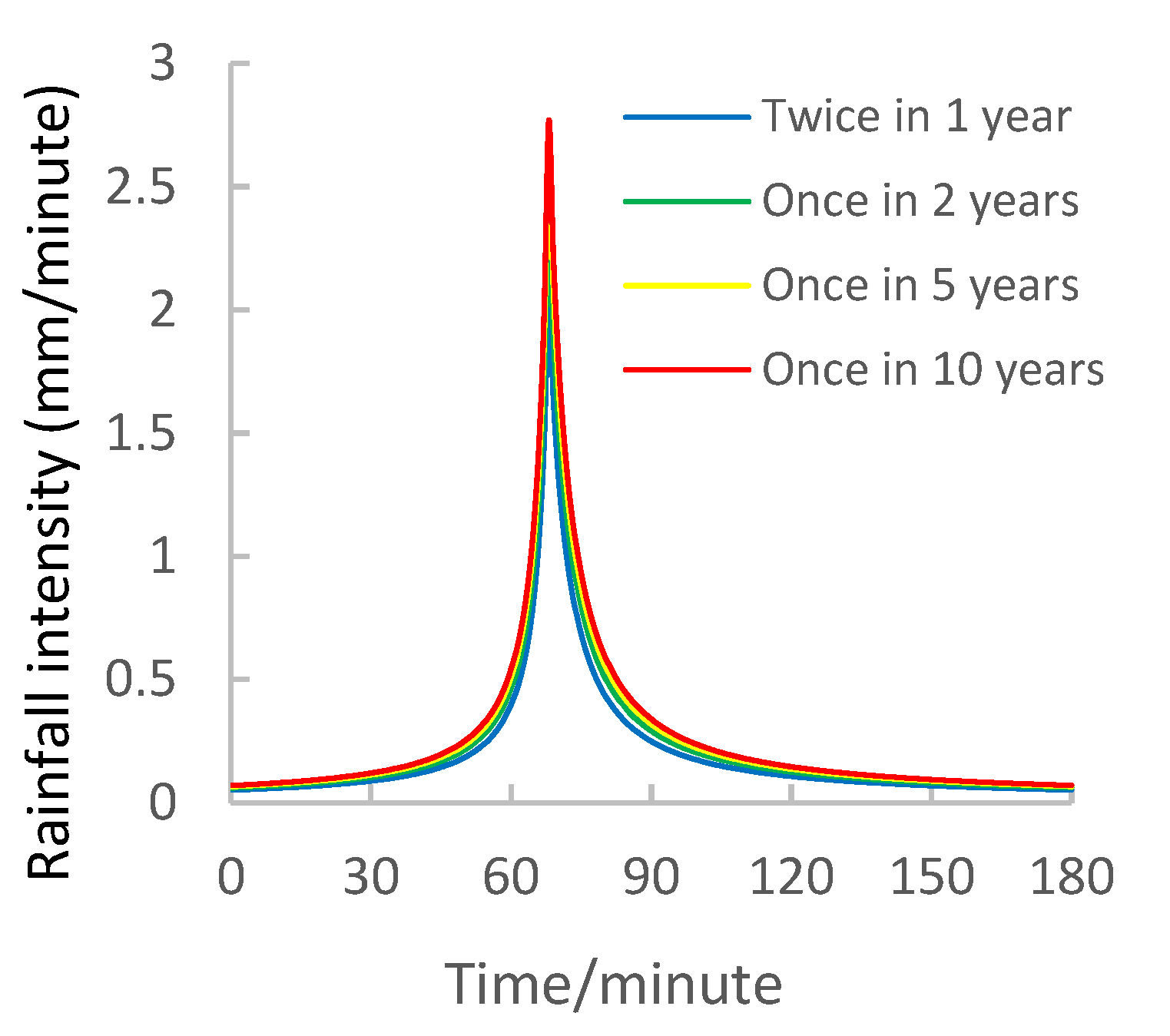
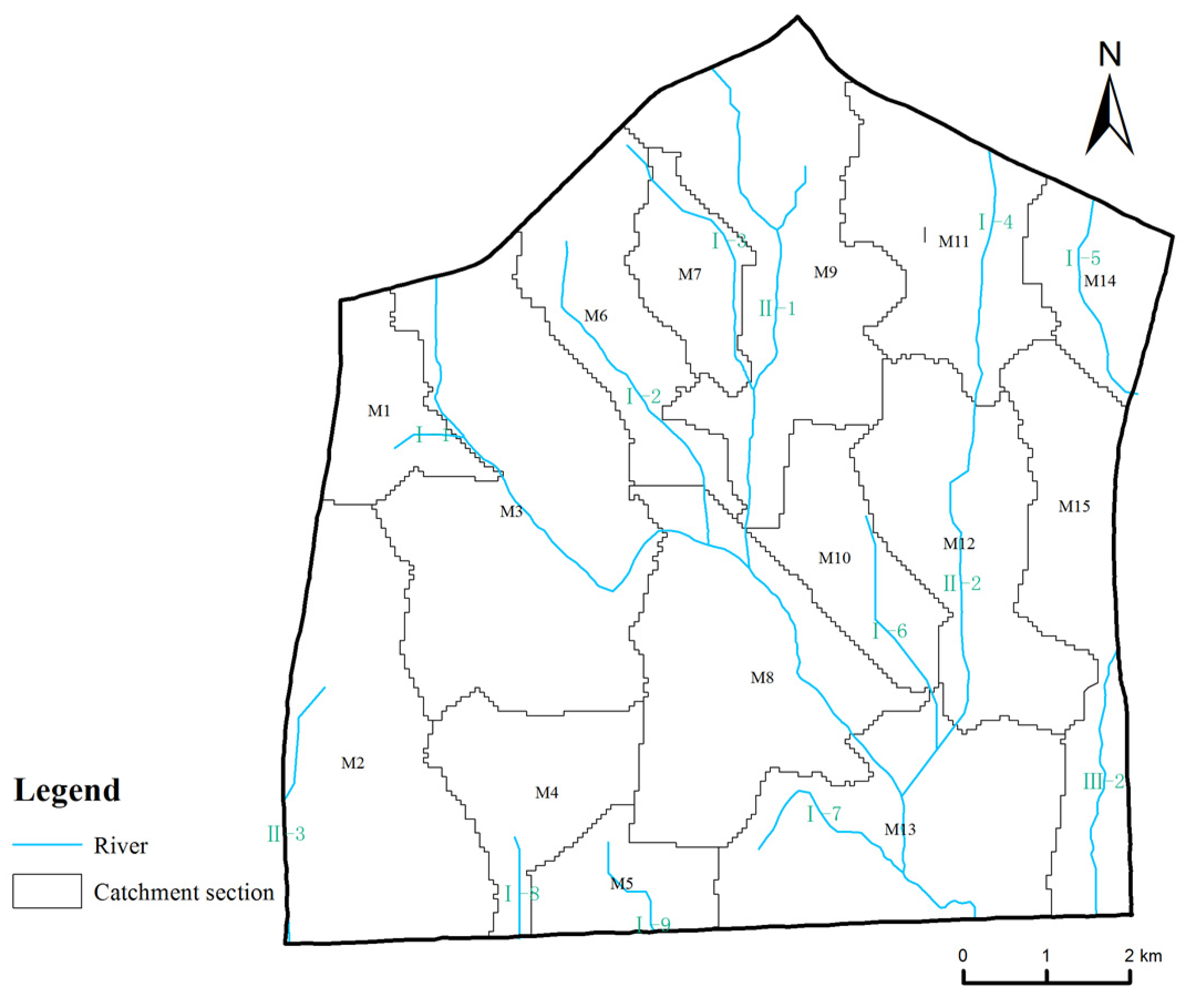

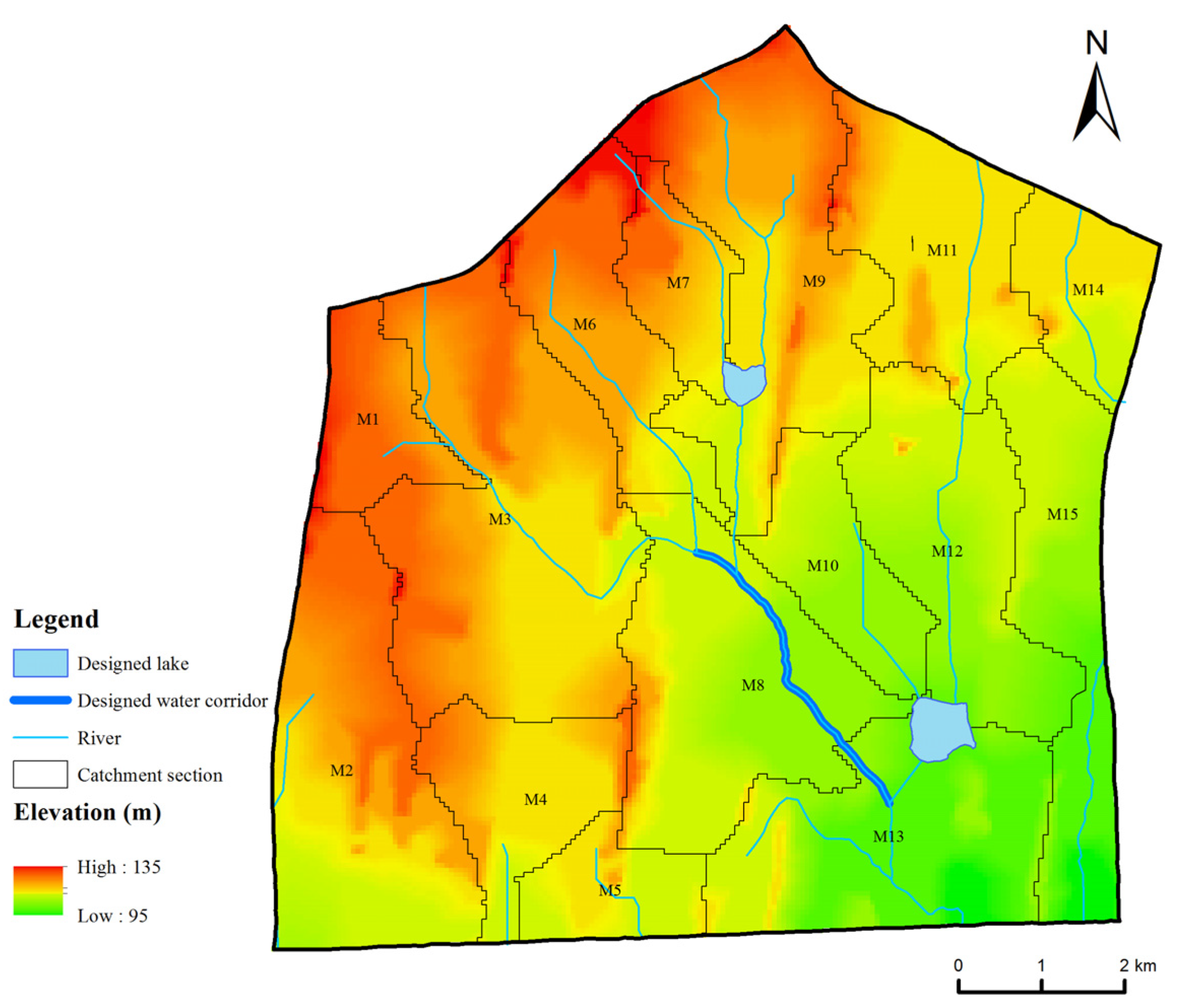
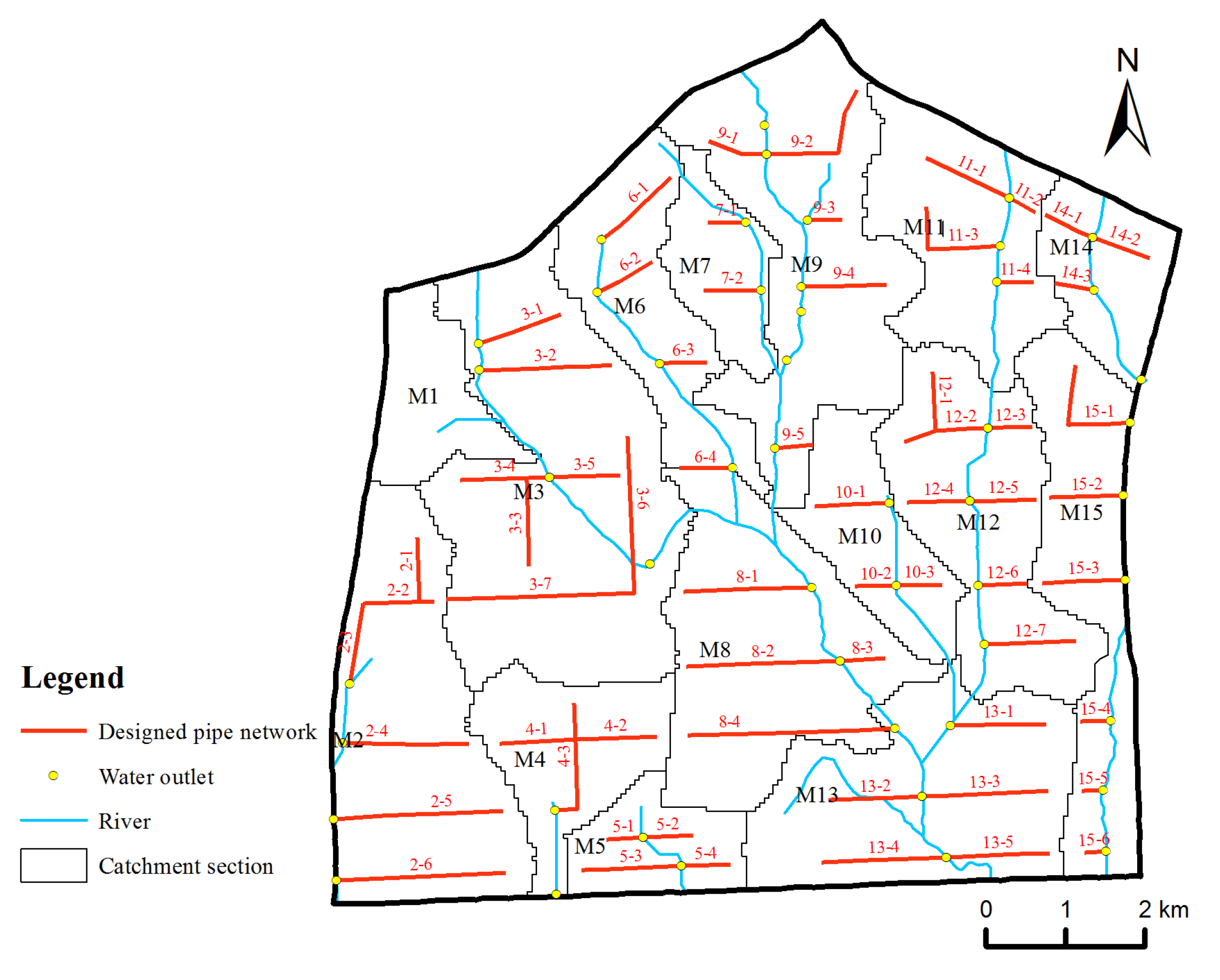
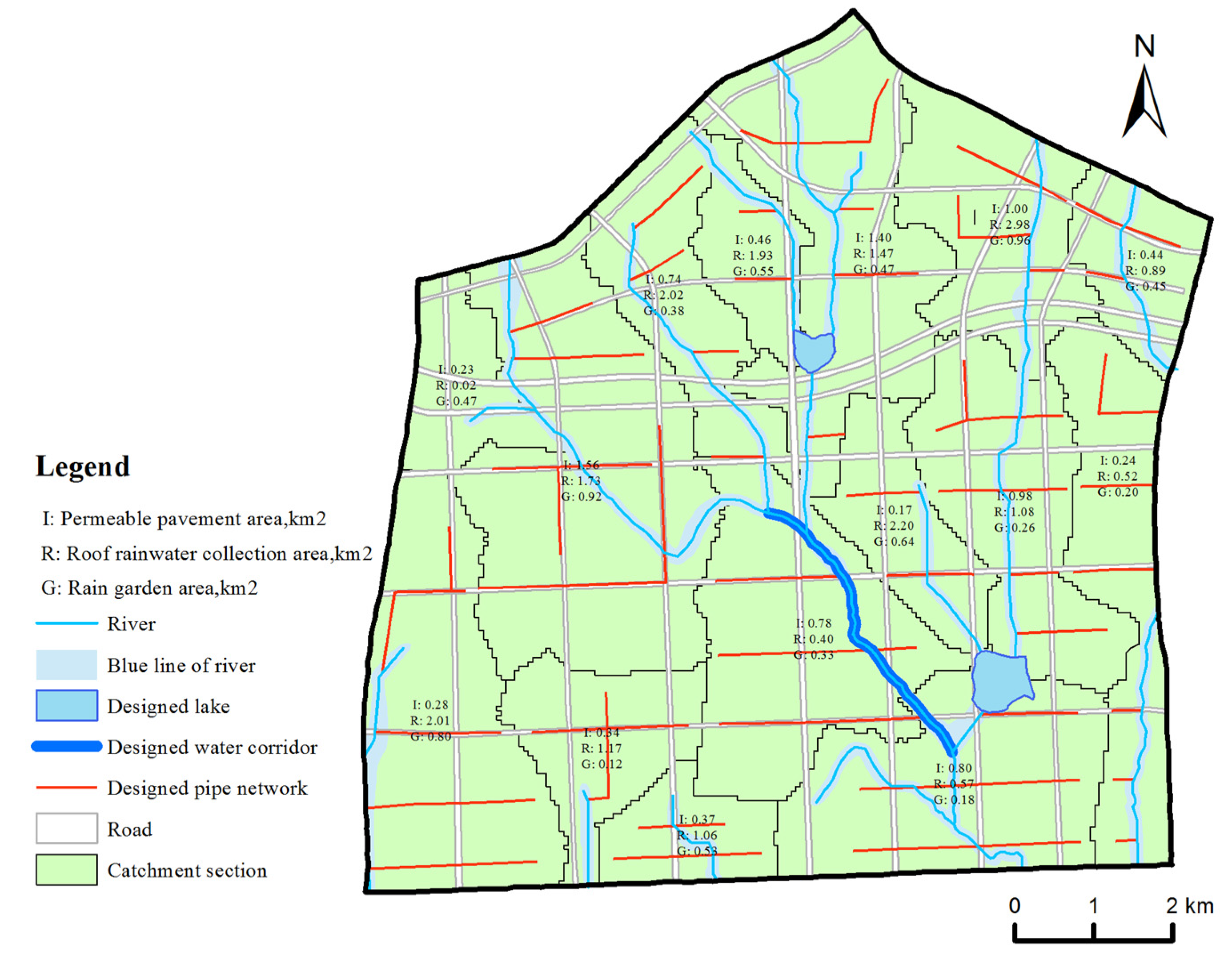
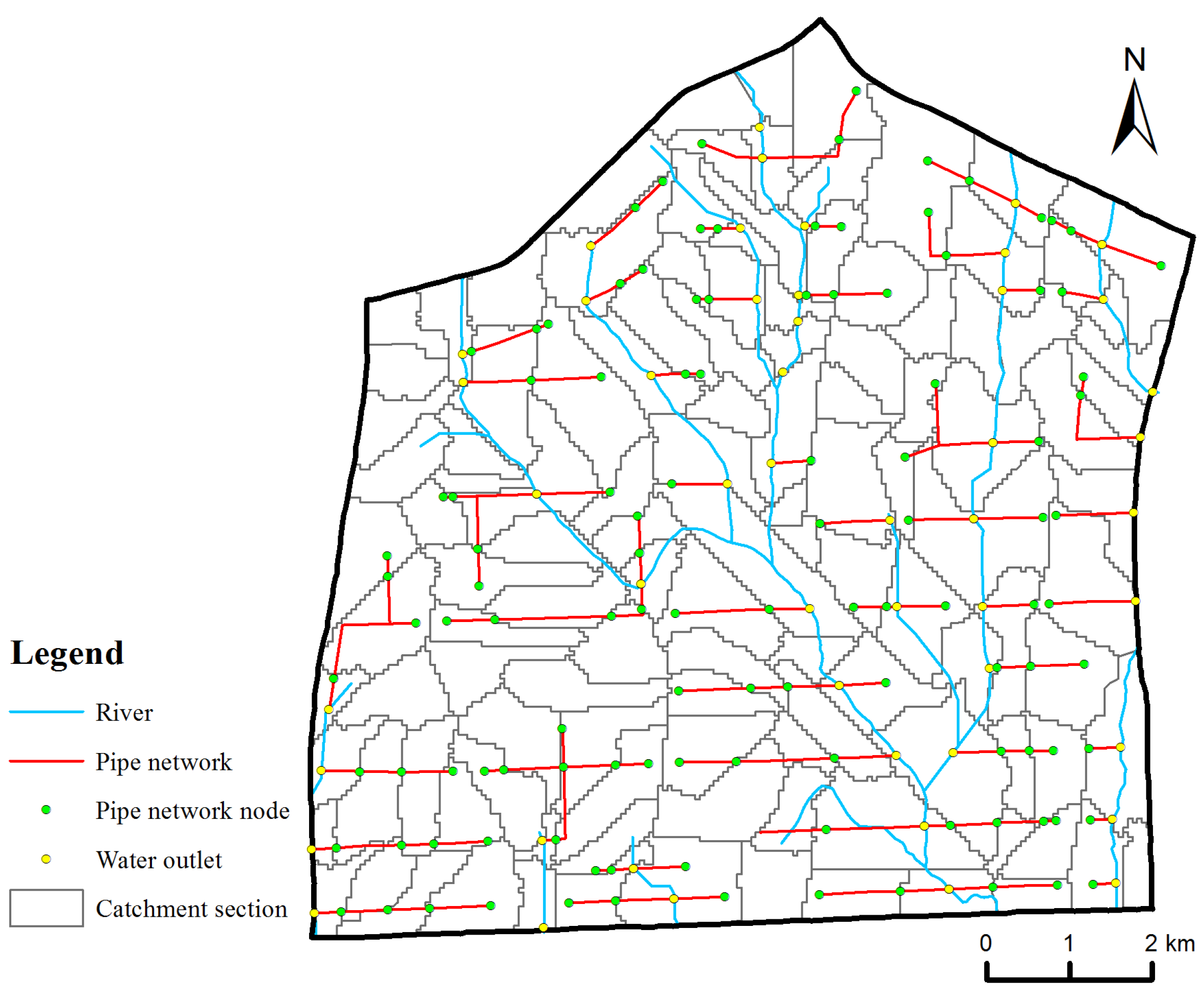
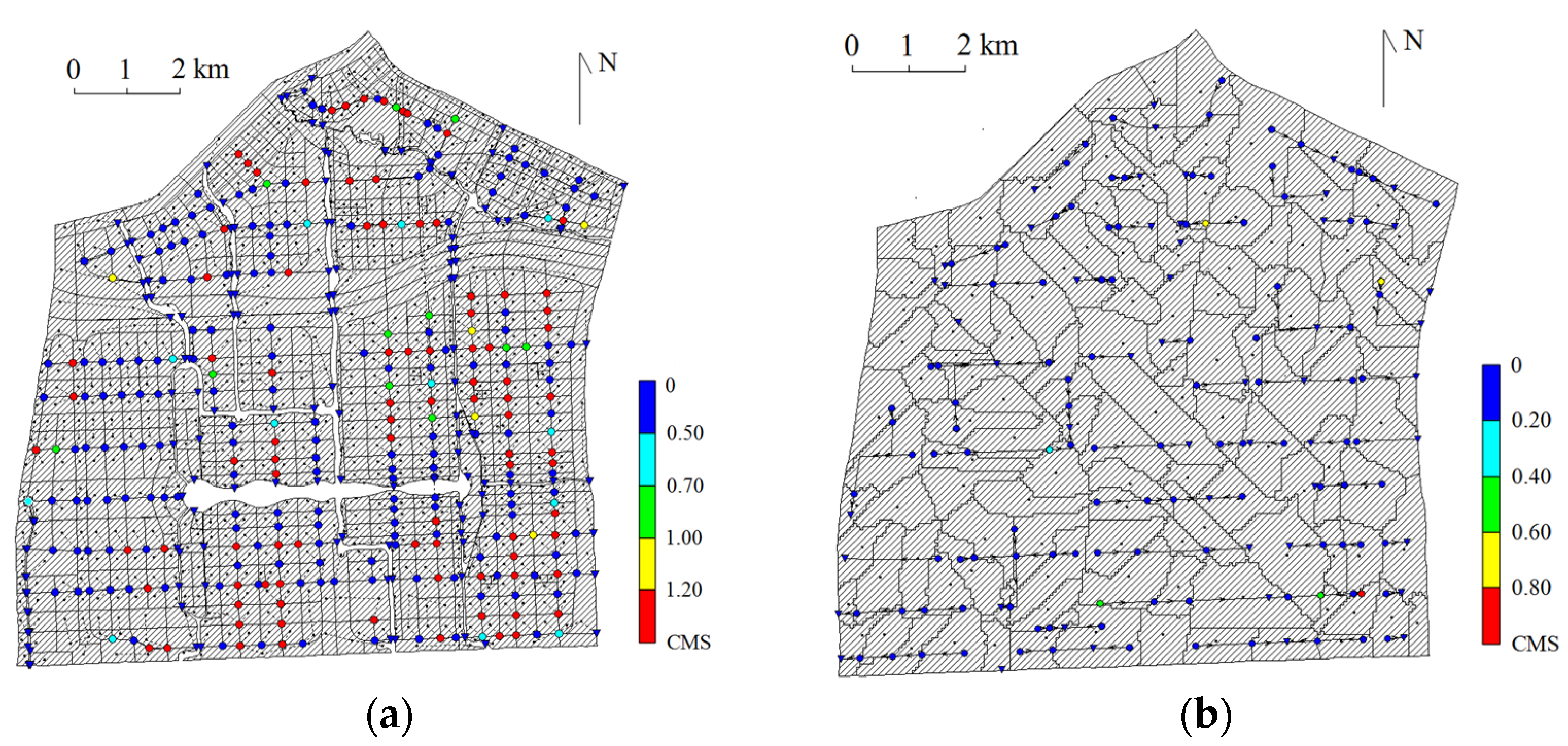
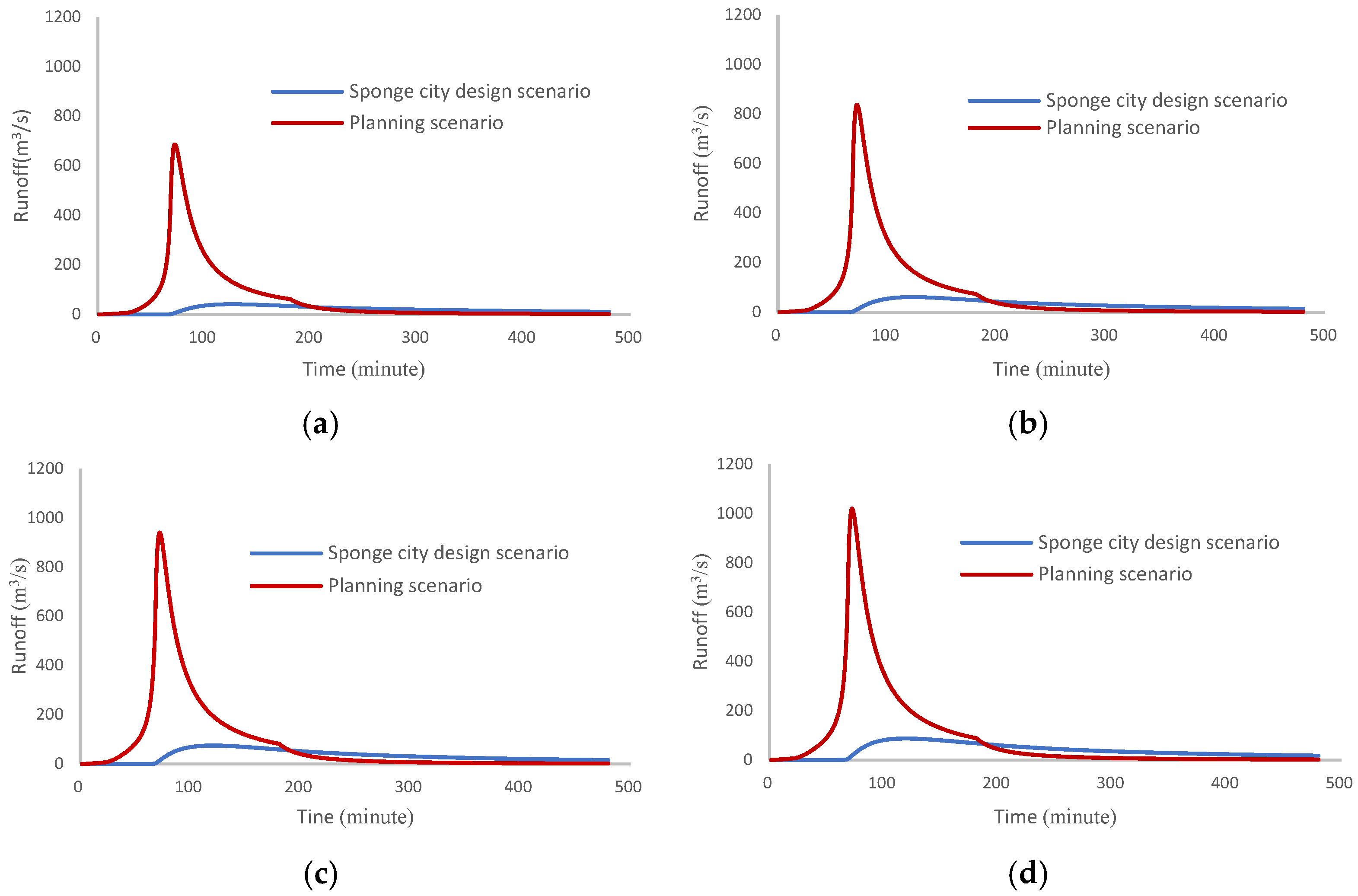

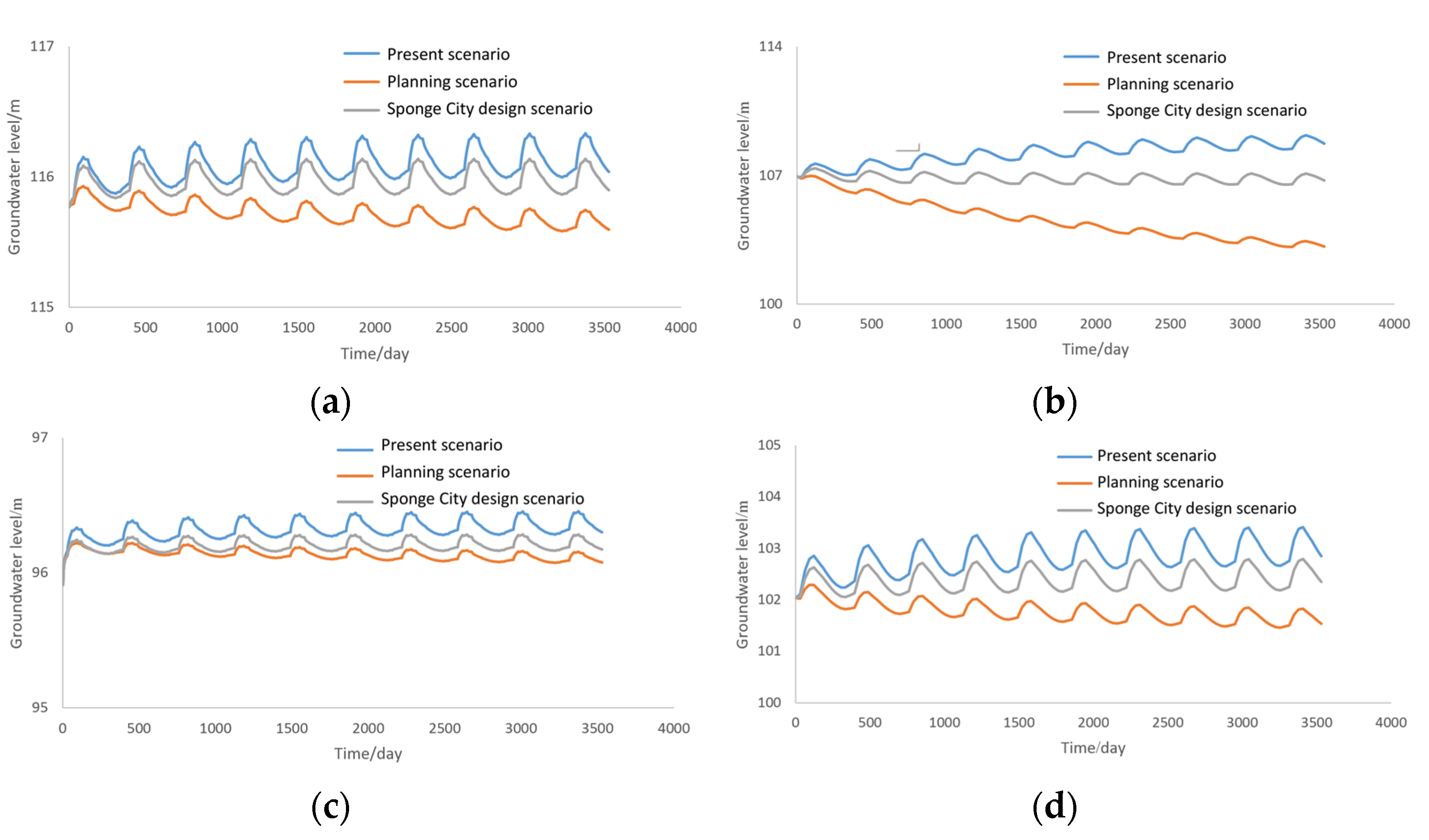
| Manning Roughness Coefficient | Depression Storage/mm | Coefficients for Horton Formula | |||||
|---|---|---|---|---|---|---|---|
| Impervious Area | Permeable Area | River Channels | Impervious Area | Permeable Area | Infiltration Rate/mm⋅h−1 | Attenuation Coefficient/h−1 | |
| Maximum | Minimum | ||||||
| 0.015 | 0.20 | 0.02 | 2.80 | 5.10 | 14.67–193.22 | 1.22–98.44 | 3–4 |
| Development Intensity | Proportion of Impervious Area | Empirical Runoff Coefficient |
|---|---|---|
| Upper-middle | >70% | 0.6~0.8 |
| Middle | 50~70% | 0.5~0.7 |
| Low-middle | 30~50% | 0.4~0.6 |
| Low | <30% | 0.3~0.5 |
| River Segment | Length /km | Catchment Area /km2 | Rate of Flow /m3s−1 | Width of River Blue Line /m |
|---|---|---|---|---|
| III-1, IV | 13.33 | 30.12 | 150.23 | 60 |
| II-1 | 7.37 | 9.68 | 57.42 | 50 |
| II-2, I-4 | 7.57 | 12.38 | 69.61 | 50 |
| I-1 | 0.49 | 2.81 | 9.45 | 30 |
| I-2 | 4.32 | 4.91 | 29.96 | 30 |
| I-3 | 3.6 | 2.53 | 16.91 | 30 |
| I-6 | 3.09 | 3.99 | 23.67 | 30 |
| III-2, I-5 | 6.31 | 9.15 | 51.45 | 50 |
| II-3 | 3.22 | 8.96 | 41.92 | 30 |
| I-8 | 1.22 | 4.11 | 17.78 | 30 |
| I-9 | 1.42 | 2.51 | 13.75 | 30 |
| Area /km2 | Proportion of Land Use Types/% | Green Space /km2 | Permeable Pavement /km2 | Green Roof /km2 | Rainwater Garden /km2 | Water Storage Depth /m | ||||
|---|---|---|---|---|---|---|---|---|---|---|
| Industrial | Residential | Commercial | Greenspace | |||||||
| M1 | 2.81 | 1.1 | 0.7 | 0.0 | 98.1 | 2.35 | 0.23 | 0.02 | 0.47 | 0.2 |
| M2 | 8.96 | 61.3 | 0.0 | 0.0 | 38.7 | 3.22 | 0.28 | 2.20 | 0.64 | 0.3 |
| M3 | 12.87 | 22.8 | 35.7 | 5.4 | 36.1 | 4.79 | 1.56 | 2.98 | 0.96 | 0.2 |
| M4 | 4.11 | 46.0 | 24.3 | 0.0 | 29.7 | 1.28 | 0.34 | 1.08 | 0.26 | 0.3 |
| M5 | 2.51 | 17.0 | 49.4 | 0.0 | 33.6 | 0.92 | 0.37 | 0.57 | 0.18 | 0.2 |
| M6 | 4.91 | 6.3 | 47.2 | 1.2 | 45.3 | 2.25 | 0.74 | 0.89 | 0.45 | 0.2 |
| M7 | 2.53 | 0.0 | 64.8 | 0.0 | 35.2 | 1.00 | 0.46 | 0.52 | 0.20 | 0.2 |
| M8 | 8.76 | 27.4 | 16.0 | 14.2 | 42.4 | 4.00 | 0.78 | 2.01 | 0.80 | 0.2 |
| M9 | 9.68 | 3.3 | 39.9 | 7.9 | 48.9 | 4.62 | 1.40 | 1.73 | 0.92 | 0.2 |
| M10 | 3.51 | 69.7 | 15.1 | 1.5 | 13.7 | 0.61 | 0.17 | 1.17 | 0.12 | 0.3 |
| M11 | 5.88 | 0.0 | 56.6 | 0.0 | 43.4 | 2.67 | 1.00 | 1.06 | 0.53 | 0.2 |
| M12 | 6.98 | 15.6 | 40.2 | 20.6 | 23.6 | 1.88 | 0.98 | 2.02 | 0.38 | 0.3 |
| M13 | 8.5 | 35.6 | 26.6 | 0.0 | 37.8 | 2.73 | 0.80 | 1.93 | 0.55 | 0.3 |
| M14 | 2.98 | 0.0 | 41.9 | 0.0 | 58.1 | 1.66 | 0.44 | 0.40 | 0.33 | 0.2 |
| M15 | 6.16 | 54.2 | 0.0 | 4.5 | 41.3 | 2.33 | 0.24 | 1.47 | 0.47 | 0.3 |
| Development Intensity | Upper-Middle | Middle | Lower-Middle | Low |
|---|---|---|---|---|
| Simulated runoff coefficient | 0.742 | 0.638 | 0.441 | 0.325 |
| Return Period /year | Rainfall /mm | Scenario | Runoff Amount /mm | Runoff Coefficient | Runoff Reduction Rate |
|---|---|---|---|---|---|
| 0.5 | 37.286 | planning | 16.673 | 0.447 | 65.5% |
| Sponge City | 5.762 | 0.154 | |||
| 2 | 43.53 | planning | 20.111 | 0.462 | 59.5% |
| Sponge City | 8.137 | 0.187 | |||
| 5 | 47.659 | planning | 22.456 | 0.471 | 56.3% |
| Sponge City | 9.848 | 0.206 | |||
| 10 | 50.784 | planning | 24.268 | 0.478 | 54.6% |
| Sponge City | 11.209 | 0.221 |
| Condition Setting | Present Scenario | Planning Scenario | Sponge City Design Scenario |
|---|---|---|---|
| Rainfall, evaporation | Annual average | ||
| Groundwater exploitation intensity | Present exploitation intensity | ||
| Proprotion of impermeable area (%) | 10.3 | 56.54 | 41.61 |
| Groundwater Balance Items | Present Scenario | Planning Scenario | Design Scenario | |
|---|---|---|---|---|
| Discharge | Exploitation | 0.683 | 0.683 | 0.683 |
| Evaporation | 0.233 | 0.0017 | 0.2705 | |
| Lateral runoff | 0.4832 | 0.1497 | 0.3749 | |
| Recharge | Precipitation | 1.8477 | 0.5862 | 0.7007 |
| LID | 0 | 0 | 0.9764 | |
| River | 0.2104 | 0 | 0.1554 | |
| Lateral runoff | 0.0495 | 0.1471 | 0.0154 | |
| Total balance | 0.7084 | −0.1011 | 0.5195 | |
Publisher’s Note: MDPI stays neutral with regard to jurisdictional claims in published maps and institutional affiliations. |
© 2022 by the authors. Licensee MDPI, Basel, Switzerland. This article is an open access article distributed under the terms and conditions of the Creative Commons Attribution (CC BY) license (https://creativecommons.org/licenses/by/4.0/).
Share and Cite
Meng, B.; Li, M.; Du, X.; Ye, X. Flood Control and Aquifer Recharge Effects of Sponge City: A Case Study in North China. Water 2022, 14, 92. https://doi.org/10.3390/w14010092
Meng B, Li M, Du X, Ye X. Flood Control and Aquifer Recharge Effects of Sponge City: A Case Study in North China. Water. 2022; 14(1):92. https://doi.org/10.3390/w14010092
Chicago/Turabian StyleMeng, Bo, Mingjie Li, Xinqiang Du, and Xueyan Ye. 2022. "Flood Control and Aquifer Recharge Effects of Sponge City: A Case Study in North China" Water 14, no. 1: 92. https://doi.org/10.3390/w14010092
APA StyleMeng, B., Li, M., Du, X., & Ye, X. (2022). Flood Control and Aquifer Recharge Effects of Sponge City: A Case Study in North China. Water, 14(1), 92. https://doi.org/10.3390/w14010092







